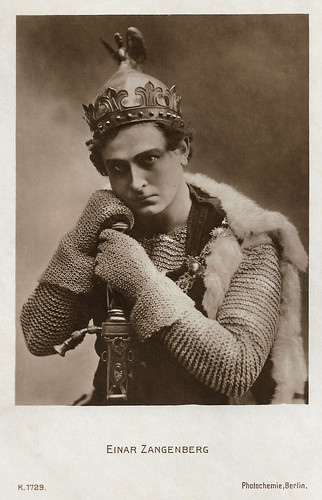
German postcard by Photochemie, no. K. 1729. Zangenberg wears the same outfit as on our card below. This refers to the Norwegian play 'Dronning Margaretha' (1834) by Adam Oehlenschläger.
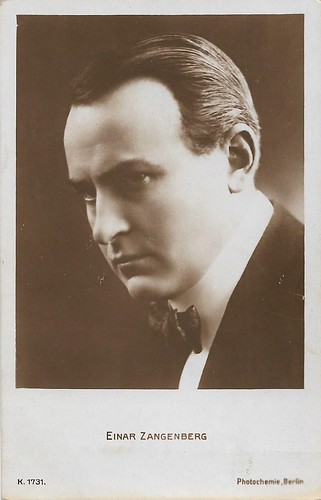
German postcard by Photochemie, no. K. 1731.
The first Danish film actor who could also fly an airplane
Einar Christian Constantin Zangenberg was born in 1882 in Copenhagen, Denmark. He was the son of the famous Danish stage actor Christian Zangenberg. Christian began his career at the Casino Theater in 1876 and joined the Royal Theatre five years later, where he remained until 1913
Einar Zangenberg received his stage training at the turn of the century at the Royal Theatre in his hometown and then performed at several private stages in the Danish capital.
In 1908, he made his film debut at Nordisk Film but did not really start until 1910, after which he quickly became one of the company's most used and prominent film stars.
Zangenberg was the first Danish film actor who could also fly an airplane - as well as drive, ride, and swim. Therefore he got various stunt roles in such films as En lektion/The aviator and the journalist's wife (August Blom, 1911), Den store flyver/The great flyer (Urban Gad, 1911), and En opfinders skæbne/The fate of an inventor (August Blom, 1912), in which he starred as a pilot ('aviator').
He played gallants and noblemen like Count Leo Zachochin in Dødsflugten (Einar Zangenberg, 1911) and von Plessen in Ungdommens ret/The right of youth (August Blom, 1911). In the adventurous sensational thriller Dr. Gar-el-Hama I: Bedraget i døden/A dead man's child (Eduard Schnedler-Sørensen, 1911), he hunts down the eponymous villain as the distinguished detective Newton.
In Millionobligationen/The Stolen Legacy (Director unknown 1911), he is an evil doctor unmasked by Sherlock Holmes (Alwin Neuss), while Zangenberg played Holmes himself in Hotelmysterierne/The Hotel Rats (Director unknown 1911). Already in 1908 he had played Holmes in Det Hemmelige Dokument/The Secret Document, one of the several Holmes films at Nordisk and directed by Viggo Larsen.
Often Einar Zangenberg was directed at Nordisk by August Blom, but surely not exclusively.
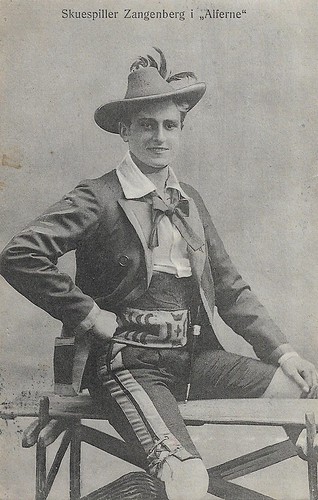
Danish postcard by Verdenspostforeningen. Mailed in 1906. Einar Zangenberg in the romantic folklore stage play 'Alferne' (The Elves, 1835) by Johan Ludvig Heiberg.
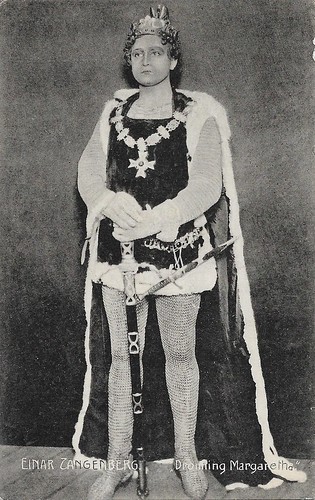
Danish postcard by C. St. Eneret, no. 4892. Einar Zangenberg in the Norwegian play 'Dronning Margaretha' (1834) by Adam Oehlenschläger. Sent in 1906. The part of Olaf in 'Dronning Margaretha' was already enacted by Zangenberg's father, Emil Zangenberg, and is considered the latter's best performance.
One of the countless victims of the notorious Spanish Flu
In 1912 Einar Zangenberg switched to the film company Kinografen, where he became director and artistic director. Until 1915, he both directed and participated in the company's films such as En Kvindes Ære/A woman's honour (1913), and Dødsklippen/The death rock (1913), both with Edith Buemann Psilander.
Shortly before the outbreak of the First World War, he joined the many Danish artists who left for Berlin, Germany, where he worked as a film director and actor. During the First World War, he directed a number of films for the companies PAGU and Flora-Film. Zangenberg himself co-starred with e.g. Trude Hesterberg and Hanni Weisse in these dramas and crime stories.
In 1917 Einar Zangenberg went to Vienna in order to produce Das Kind meines Nächsten/My neighbour's child (Einar Zangenberg, 1918), a top-level propaganda film for the welfare of war-damaged children. Empress Zita herself appeared in front of the camera, Zangenberg himself played the leading role.
With the A-Zet-Film, Einar Zangenberg also owned his own Austrian production company. At the end of April 1918, he left his by now established residence in Vienna.
Einar Zangenberg suddenly died in Vienna in 1918. He was only 35. German Wikipedia cites a 1918 obituary in the Neue Kino-Rundschau which stated he died in a sanatorium after a stomach operation. IMDb and Danish Wikipedia instead state that he was one of the countless victims of the notorious Spanish Flu.
All in all, Einar Zangenberg acted in 61 films and directed 32 films. Zangenberg was married to the actress Alfi Zangenberg (1882-1966), who had moved with him to Berlin and also starred in many of his films.
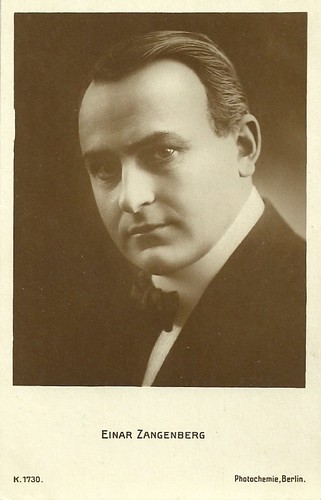
German postcard by Photochemie, Berlin, no. K. 1730.

Danish postcard by Alex Vincent Konstforlag, Eneret, no. 516. Card sent in 1906. A painted portrait of Christian Zangenberg (1853-1914), a prominent actor of the Danish Royal Theatre and the father of Einar Zangenberg.
Sources: Wikipedia (German and Danish), and IMDb.
No comments:
Post a Comment